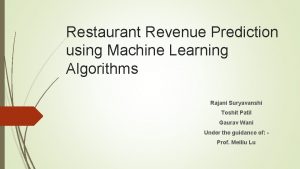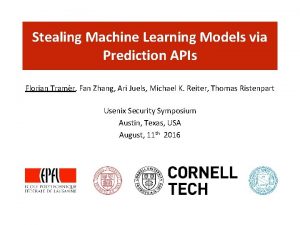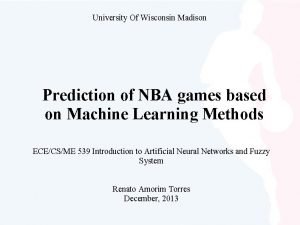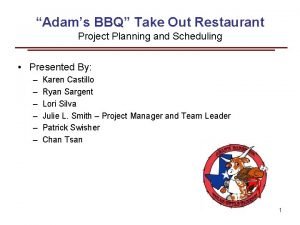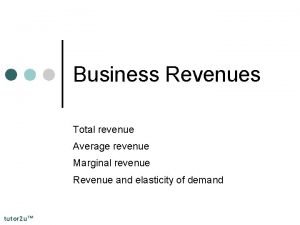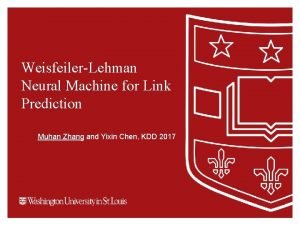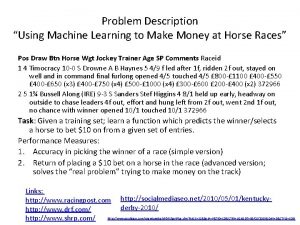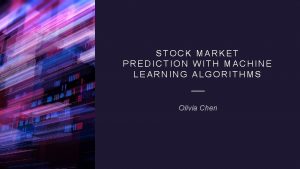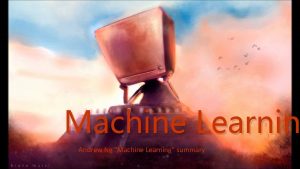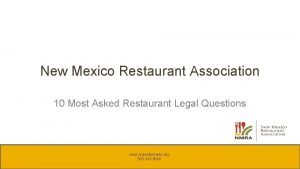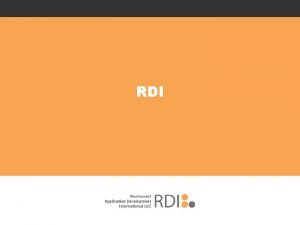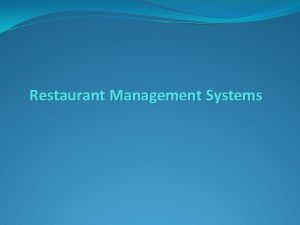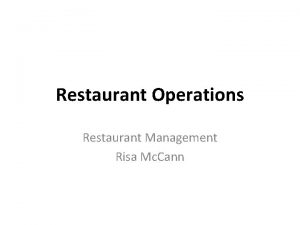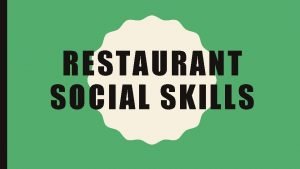Restaurant Revenue Prediction using Machine Learning Algorithms Rajani



















- Slides: 19

Restaurant Revenue Prediction using Machine Learning Algorithms Rajani Suryavanshi Toshit Patil Gaurav Wani Under the guidance of: Prof. Meiliu Lu

Problem Statement New restaurant sites take large investments of time and capital to get up and running. When the wrong location for a restaurant brand is chosen, the site closes within 18 months and operating losses are incurred. TFI had organized a competition on Kaggle for prediction of restaurant’s revenue. There are 100, 000 regional locations for which revenue needs to be predicted depending upon various data fields mentioned in database. The main purpose of this project is to predict revenue of the restaurants in the given test dataset from the already established restaurant data by using Machine Learning Algorithms.

Literature Review Read discussion forums which described the problem statement more in detail. Found out multiple approaches that could be used to solve this challenge. Helped us realize in advance that our dataset needs a lot of pre-processing. Discovered the over-fitting solution submitted with 0 RMSE value.

Dataset consists of following fields: - Id : Restaurant id. Open Date : opening date for a restaurant City : City that the restaurant is in. City Group: Type of the city. Big cities, or Other. Type: Type of the restaurant. FC: Food Court IL: Inline DT: Drive Thru MB: Mobile P 1 - P 37: These are the p-variables and are a measure of the following: Demographic data: Population, age, gender distribution, development scale Real Estate Data: M 2 of the location, front façade, car parking etc. Commercial data: schools, banks etc. REVENUE: The revenue column indicates a (transformed) revenue of the restaurant in a given year and is the target of predictive analysis.

Insights of the Training Data There are 137 rows and 43 features in training data. Training data shows variation in revenue depending upon City, Open Date and Type. There are 38 unique cities and uni-codes are mentioned in the city names. Revenue column is left skewed and it’s representation after taking logarithm is shown below : -

Variation in P-Values P-values are indicating Real estate data, Commercial data and population related information. Following is chart showing obfuscated values of P-variables.

Representation of City Vs Revenue http: //athena. ecs. csus. edu/~patiltr/geomap. html

Insights of Testing Data There are 100, 000 rows and 42 features in test data. There are 54 unique cities and uni-codes are mentioned in the city names. There are more than 20 additional cities in test data and one additional type Restaurant Type – MB(Mobile).

Score Measure: RMSE The score measure presented in the competition is the root mean squared error of the test set revenue. Where yi is the predicted revenue of the ith restaurant and y is the actual revenue of the ith restaurant.

PRE-PROCESSING Since the training dataset is very small and we have to make the best out of what is available, we required a lot data preprocessing. This was the most difficult step of our Project.

Formatted Open-Date into three columns date, month and year. Using Boruta package, we found that year plays crucial role in predicting the revenue. Open Date (mm/dd/yyyy) 07/17/1999 03/09/2013 Month Day Year 07 17 1999 03 09 2013

To over-ride issue with an additional type in test data, we have replaced MB with FC and DT with IL.

Removed outliers in revenue column.

Converting all the selected train and test data into numeric. Converted categorical data into numeric. The predictor’s input must be numeric, hence converted all the selected data columns into numeric. Boruta package for feature selection Other Pre-Processing Approaches tried and in-efficient. Mice Imputation for removing Zeroes Reducing values of Obfuscated P-variables Principal Component Analysis of P-variables

SVM Regression Support Vector Machine can be applied not only to classification problems but also to the case of regression. Model in R using SVM: fit<- svm(x=as. matrix(train_cols), y=labels, cost=10, scale=TRUE, type="eps-regression") predict_svm<-as. data. frame(predict(fit, newdata=testdata)) RMSE Value: - 1. Public Score : 1947658. 58962 2. Private Score: 2259411. 40638

Random Forest Algorithm Random Forest is one of the best useful technique used for multiple decision tree generation. Since our dataset contains lots of attributes to consider for the prediction, we built the model with it. Model in R using Random Forest: rf = cforest(train$revenue ~. , data = train_cols, controls=cforest_unbiased(ntree=1000)) Prediction = predict(rf, testdata, OOB=TRUE, type = "response") RMSE Value : - 1. Public Score : 1847620. 47650 2. Private Score: 2159509. 40783

Gradient Boosting Machine One of the most efficient algorithm. Gradient boosting = Gradient descent + Boosting This is much similar to that of Ada-Boosting technique, that we introduce more of weak learner to compensate shortcomings of existing weak learner Gradient boosting was introduced to handle a variety of loss function Basically, consecutive trees are introduced to solve net loss of prior trees Result of new trees are partially applied the entire solution RMSE Value: - 1. Public Score : 1735157. 84896 2. Private Score: 1809970. 61757

Conclusion Random Forest works the best on our preprocessed data. Gradient Boosting Machine is working much better than SVM. Preprocessing of data is very important. It improved our RMSE scores drastically. Algorithm Public Score Private Score GBM 1892936. 84870 1866654. 72370 Random Forest 1765716. 60593 1812835. 346 SVM 1801175. 32591 2104348. 55376

References “Dataset: Restaurant Revenue Prediction”, https: //www. kaggle. com/c/restaurantrevenue-prediction Blog: http: //rohanrao 91. blogspot. com/2015/05/tfi-restaurant-revenueprediction. html Bikash Agrawal , ” Kaggle Walkthrough: Restaurant Sales Prediction”, Boost AI, University of Stavanger. Nataasha Raul, et al. “Restaurant Revenue Prediction using Machine Learning”, International Journal of Engineering Science, Vol. 6, Issue 4 Sauptik. Dhar, Vladimir Cherkassky, “Visualization and interpretation of SVM Classifiers”, Wiley interdisciplinary Reviews V 2 Maestros, “Applied Datascience with R”, [Lecture Notes]
 Machine learning algorithms for restaurants
Machine learning algorithms for restaurants Rajani shenoy
Rajani shenoy Avoiding discrimination through causal reasoning
Avoiding discrimination through causal reasoning Stealing machine learning models via prediction apis
Stealing machine learning models via prediction apis Prediction of nba games based on machine learning methods
Prediction of nba games based on machine learning methods Stealing machine learning models via prediction apis
Stealing machine learning models via prediction apis Dr zareen syed
Dr zareen syed Project charter for opening a restaurant
Project charter for opening a restaurant Average
Average Weisfeiler-lehman neural machine for link prediction
Weisfeiler-lehman neural machine for link prediction How to make money using machine learning
How to make money using machine learning Concept learning task in machine learning
Concept learning task in machine learning Analytical learning in machine learning
Analytical learning in machine learning Pac learning model in machine learning
Pac learning model in machine learning Machine learning t mitchell
Machine learning t mitchell Inductive vs analytical learning
Inductive vs analytical learning Analytical learning vs inductive learning
Analytical learning vs inductive learning Instance based learning in machine learning
Instance based learning in machine learning Inductive learning machine learning
Inductive learning machine learning First order rule learning in machine learning
First order rule learning in machine learning
